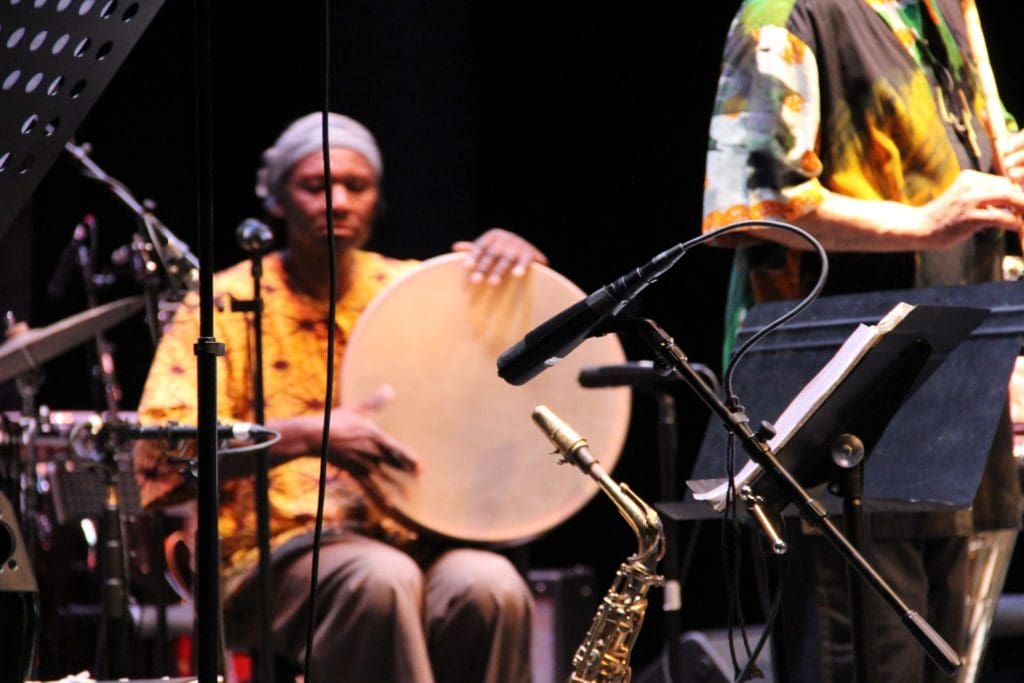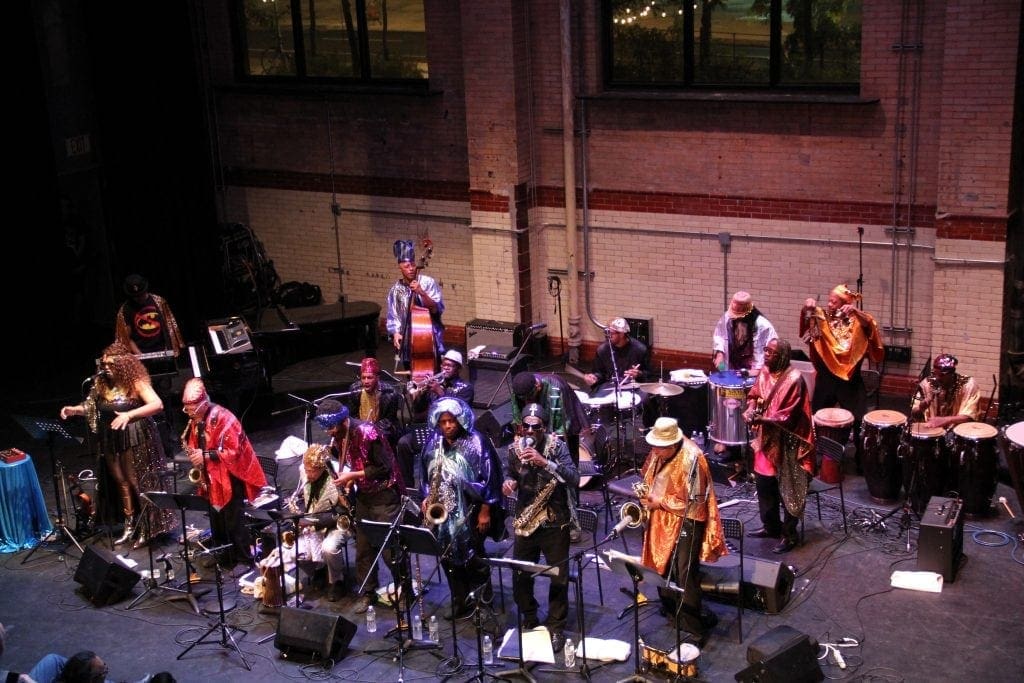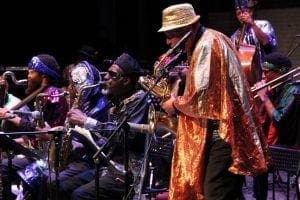Recapping Opening Night of The October Revolution
Last night, The October Revolution kicked off in revelatory fashion. The festival, organized by Ars Nova Workshop and co-presented by FringeArts, runs through the weekend and is named in tribute to a revolutionary 1964 DIY jazz festival of the same name, curated and produced by the late legend Bill Dixon. With a lineup featuring some of the most thoughtful, adventurous music inventors and performers of our time, from across a diverse range of genres that span jazz, free improvisation, and contemporary classical and radiate outward, it’s a new music festival of a caliber rarely seen in our city, one where the act of “listening”—not for anything specific, but rather the experience of the act—is paramount.
 Opening the festival was Karuna, the duo of longtime friends and collaborators Hamid Drake and Adam Rudolph, here made a trio with the addition of master multi-instrumentalist and Rudolph collaborator Ralph Miles Jones. It’s a shame that there are no official recordings of this unit because their set was utterly engrossing from beginning to end, moving fluidly through musical styles and instrumentation, and, in a way, exemplifying the festival’s emphasis on listening.
Opening the festival was Karuna, the duo of longtime friends and collaborators Hamid Drake and Adam Rudolph, here made a trio with the addition of master multi-instrumentalist and Rudolph collaborator Ralph Miles Jones. It’s a shame that there are no official recordings of this unit because their set was utterly engrossing from beginning to end, moving fluidly through musical styles and instrumentation, and, in a way, exemplifying the festival’s emphasis on listening.
Drake and Rudolph are two of the most innovative, influential and creative percussionists of the last century and their friendship goes all the way back to a chance encounter at a downtown Chicago drum shop when the pair was just fourteen. From there they’d both go on to collaborate with a veritable who’s who of mid-century jazz legends, including Don Cherry who they both toured with for some time. In 1977 the pair joined Gambian musician and composer Foday Musa Suso to form the Mandingo Griot Society, a unit that explored and fused West African and American musical idioms, and one that is credited as an early “world music” innovator. While that’s a pretty loaded terms these days, back then the idea of melding non-Western musical instrumentation and idioms into Western styles had yet to be so rampantly, clumsily trodden. Rudolph in particular helped pioneer this kind of experimentation, and the arsenal of instruments he had at his disposal last night was exemplary of the breadth of his musical fluency. The same was true for Jones—a composer, educator, ethnomusicologist, and multi-diasporic aerophonist—who had an array of wind instruments from a variety of musical traditions at his side that he’d pick and choose from throughout the evening.
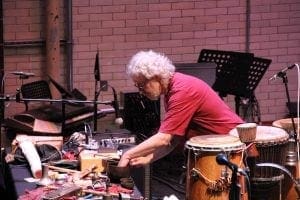 From the get go this trio’s near-telepathic chemistry was apparent. Spread out among the many chairs, stands, and instruments awaiting the evenings headliner, each player had no need to look at each other to coordinate. The level of deep listening and musical sensitivity they were exhibiting was astounding and it was exhilarating to watch them pick up the subtlest of cues from each other and effortlessly follow suit. The music was at times delicate—such as when Drake and Rudolph both provided a thumb piano backing to Jones’ soprano sax soloing or when Rudolph brought out a sintir and throat sang or when Drake virtuosically pattered a frame drum—and at other times raucous, propulsive. Watching Drake and Rudolph exchanging amused glances as they steadily upped the rhythmic ante while going all in on their drum kit and hand drum set, respectively, was a real joy and felt like a peak into the rapport of these two old friends.
From the get go this trio’s near-telepathic chemistry was apparent. Spread out among the many chairs, stands, and instruments awaiting the evenings headliner, each player had no need to look at each other to coordinate. The level of deep listening and musical sensitivity they were exhibiting was astounding and it was exhilarating to watch them pick up the subtlest of cues from each other and effortlessly follow suit. The music was at times delicate—such as when Drake and Rudolph both provided a thumb piano backing to Jones’ soprano sax soloing or when Rudolph brought out a sintir and throat sang or when Drake virtuosically pattered a frame drum—and at other times raucous, propulsive. Watching Drake and Rudolph exchanging amused glances as they steadily upped the rhythmic ante while going all in on their drum kit and hand drum set, respectively, was a real joy and felt like a peak into the rapport of these two old friends.
After a short break allowing everyone a chance to get a beer in hand, audience members packed back into the theater for what was sure to be an (inter)stellar experience. Playing to a full house and a full moon, the Sun Ra Arkestra brought down the house, as they always do, with a joyous performance centered around their seminal 1973 album Space is the Place.
A mid career highlight within Sun Ra’s dauntingly vast discography, the album serves as an ideal entry points for those unfamiliar with the Arkestra’s essential works. Each track is varied in style and imbued with some hallmark of Sun Ra’s singular musical vision. “Images” is a classic, swinging tune, albeit in a wonderfully raucous fashion. There’s a strain of Egyptian exotica running through “Discipline.” “Sea of Sounds” is a total, futuristic, free jazz mind-melter. The frenetic “Rocket Number Nine” captures the Arkestra in a characteristic freewheeling, humorous form that plays like (and actually is) a much more out there version of Sun Ra’s work writing music for doo-wop and vocal groups in the mid-‘50s. And of course, there’s that most classic of cuts, the titular opening track that feels about as exemplary of Sun Ra’s vision as a single track can get. Suffice it to say it does fall pretty short of capturing it all, but what one song wouldn’t?
As the sixteen-piece entered the theater—draped in their iconic, dazzling Afrofuturist attire—they wasted no time getting situated. No sooner had a performer taken their seat than they launched into a spot on rendition of “Images” that got the audience moving in their seats and allowed them to appreciate the accretion of sounds as instruments steadily joined the party. Bandleader Marshall Allen—the legendary, 93-year-old(!) alto saxophone player and EVI adept who’s been with the Arkestra since it’s earliest days, assuming leadership after Sun Ra’s earthly departure in 1993—was as attuned to the Arkestra’s many moving parts as ever, conducting with steady sweeps of his arm even as he wailed on his sax. Alongside the album cuts, they performed two other highlights from the history of the Arkestra: “Angels and Demons at Play” from the album of the same name, featuring music by Allen and words by Sun Ra, and a song by the great former Arkestra member and jazz innovator Phil Cohran who sadly passed away earlier this year. It’s always astounding how much jazz history gets woven into an Arkestra set, how many luminaries who’ve passed through their ranks are paid tribute, but it’s all owing to the fact that the group has been such an essential part of jazz history for more than half a century.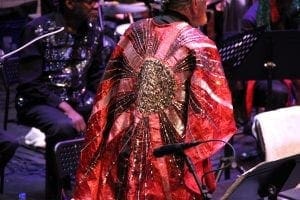
I’ve always found seeing the Arkestra to be a musically rejuvenating experience. The first time I saw them came at a point when I was feeling less and less engaged by the live music I’d been witnessing, even less and less interested in the recorded music I’d been consuming. But once they got going, I let go of all that negativity. Even some 60+ years into their existence, they never fail to get audiences beaming and swinging, and last night was no exception. A fitting way to kick off a weekend packed with such monumental music.
—Hugh Wilikofsky
All photos by Hugh Wilikofsky.

